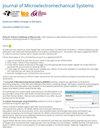用于脂质囊泡控制融合的高纵横比电极电融合装置
IF 3.1
3区 工程技术
Q2 ENGINEERING, ELECTRICAL & ELECTRONIC
引用次数: 0
摘要
由于巨脂质体或巨囊泡能够与其他囊泡融合以混合其内容物,因此已被用作动态生物反应器。在各种原理中,电熔合尤其有用,因为它快速且不需要交换溶液。在传统的囊泡融合方法中,由于囊泡由于意外流动而漂浮和移动,通常难以对融合事件进行定量评估。在本研究中,我们开发了一种微流控装置,该装置配备了用于结构捕获的微室和用于囊泡融合的电极,可以在确定的位置观察到融合现象。具体来说,我们制造了一种电融合装置,它具有导电硅电极和PDMS微室,可以容纳巨大的单层囊泡(GUVs;直径$\gt 6~ $\ mu $ m)到位。通过检测两个囊泡群体内部内容物混合后出现的荧光标记,检测GUV-GUV和GUV-小GUV(直径$\lt 2~\mu $ m)的融合率。该结构可用于实现平行电融合分析,定量分析模拟细胞环境中的生化反应。(2024 - 0166)本文章由计算机程序翻译,如有差异,请以英文原文为准。
Electrofusion Device With High-Aspect-Ratio Electrodes for the Controlled Fusion of Lipid Vesicles
Giant liposomes or giant vesicles have been used as dynamic bioreactors because of their ability to fuse with other vesicles to mix their contents. Among various principles, electrofusion is particularly useful because it is quick and does not require solution exchange. In conventional vesicle fusion methods, quantitative evaluation of fusion events has often been difficult because vesicles float and move due to the unexpected flow. In this study, we developed a microfluidic device equipped with microchambers for structural trapping and electrodes for vesicle fusion, in which the fusion phenomenon can be observed in definite locations. Specifically, we fabricated an electrofusion device that had conductive silicon electrodes and PDMS microchambers that held giant unilamellar vesicles (GUVs; diameter $\gt 6~\mu $ m) in place. The fusion yield of GUV-GUV and GUV-small GUV (diameter $\lt 2~\mu $ m) was examined by detecting the fluorescence marker that appeared upon the mixing of internal contents of two vesicle populations. This architecture can be used to realize parallel electrofusion assays for quantitatively analyzing biochemical reactions in the cell-mimetic environment. [2024-0166]
求助全文
通过发布文献求助,成功后即可免费获取论文全文。
去求助
来源期刊

Journal of Microelectromechanical Systems
工程技术-工程:电子与电气
CiteScore
6.20
自引率
7.40%
发文量
115
审稿时长
7.5 months
期刊介绍:
The topics of interest include, but are not limited to: devices ranging in size from microns to millimeters, IC-compatible fabrication techniques, other fabrication techniques, measurement of micro phenomena, theoretical results, new materials and designs, micro actuators, micro robots, micro batteries, bearings, wear, reliability, electrical interconnections, micro telemanipulation, and standards appropriate to MEMS. Application examples and application oriented devices in fluidics, optics, bio-medical engineering, etc., are also of central interest.
 求助内容:
求助内容: 应助结果提醒方式:
应助结果提醒方式:


